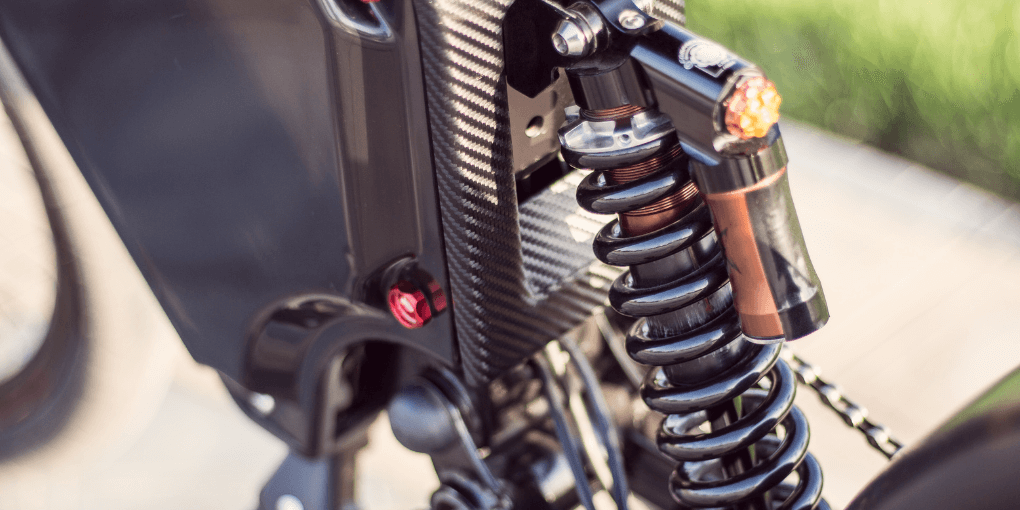Dirt Bike Suspension : Fine-Tuning for Best Performance
“Suspension tuning is like finding the perfect tune for your favorite song. It’s all about hitting the right notes.” – Moto Enthusiast
“Suspension” is like the bike’s cushioning system. It includes springs and shock absorbers.
They help the bike handle bumps and shakes on rough terrain more smoothly. It’s like having built-in shock absorbers to make the ride less bumpy and more comfortable.

In this blog, we’ll talk about dirt bike suspension. We’ll learn what it’s made of and how to make it work just right for you.
So, Fasten your seatbelt and let’s make your riding experience even more awesome!
Importance of Suspension Tuning
Suspension tuning is super important for making your dirt bike work at its best. Adjusting the suspension system of your bike helps make it easier to control.
It also makes the bike more stable and comfortable. As a result, your ride becomes smoother, regardless of where you go.
Following are the reasons suspension tuning is so important. And before taking action, you need to understand its importance properly.
Better Control
When you tune the suspension, it helps you control your dirt bike better. This is especially true on rough roads or when you hit bumps.
Stability Boost
It also stops your bike from bouncing around too much. This keeps it steady and helps avoid accidents.
Comfy Rides
When your suspension is set up right, it absorbs bumps and rough patches. This makes long rides less tiring.
Ready for Any Terrain
Different surfaces need different suspension settings. By tuning it, your bike can handle rocky paths, sandy stretches, or smooth roads without a hitch.
Personal Touch
You can tweak the suspension to match how you like to ride, making it feel just right for you.
Keep It Going
Regular tuning helps keep your bike in top shape, so it lasts longer and performs well over time.
Basics of Dirt Bike Suspension
Before we dive into the details, let’s first understand some simple terms to make things easier.Knowing these terms will make it simpler to adjust your bike’s suspension.
Components
Forks: These are like arms for the front of the bike. They help the bike handle bumps at the front.
Shocks: These are like springs for the back of the bike. They help the back handle bumps.
Key Terms
- Compression: This means how much the suspension squishes down when it hits a bump.
- Rebound: This means how fast the suspension goes back up after it squishes down.
- Sag: This is how much the suspension squishes down when you’re sitting on the bike.
- Preload: This is adjusting how tight the suspension is based on your weight.
Understanding Suspension Adjustments
Each of the following adjustments plays a crucial role in how the bike behaves and how comfortable the ride is for the rider.
By fine-tuning these settings, riders can tailor their bike’s suspension to suit their riding style and the terrain they’re tackling.
Compression Damping
Compression damping is like controlling how quickly your bike’s suspension squishes down when you hit a bump or land from a jump.
You can make it harder or softer. Making it harder means the suspension doesn’t squish down as fast, which is good for smoother surfaces. Making it softer lets the suspension squish down more easily, which is better for rough ground.
Rebound Damping
Rebound damping is about how fast the suspension goes back to its normal position after squishing down.
If you make it slower, the suspension takes longer to come back up, which can help keep your bike steady over rough bumps. If you make it faster, the suspension comes back up quickly, which is good for keeping your wheels on the ground during jumps.
Spring Preload
Spring preload is about adjusting how tight the suspension springs are when your bike isn’t moving.
Making it higher makes the suspension stiffer, which is good if you’re heavier or carrying lots of stuff. Making it lower makes the suspension softer, which helps if you’re lighter or riding on softer ground.
Sag
Sag is how much the suspension squishes down when you sit on your bike. It’s important because it affects how much your suspension can still squish down to soak up bumps.
Setting sag right means adjusting the suspension so it squishes down just enough when you sit on it.
This keeps your suspension in the best position for handling bumps and keeping your tires on the ground.
Fine-Tuning Techniques
Following these step-by-step techniques and making incremental adjustments, you can fine-tune your dirt bike’s suspension settings to enhance its performance and your riding experience.
Step 1: Determine Baseline Settings
Understand Your Bike
Start by familiarizing yourself with your dirt bike’s owner’s manual. It often provides recommended baseline settings for suspension based on factors like rider weight, riding style, and terrain.
Set Sag
Measure and adjust the sag according to the manufacturer’s recommendations. This ensures the suspension is properly balanced for your weight and riding style.
Note Initial Settings
Take note of the initial settings of compression damping, rebound damping, and spring preload. This gives you a reference point to return to if needed.
Step 2: Assess Riding Conditions
Analyze Terrain
Consider the type of terrain you’ll be riding on—rocky trails, sandy tracks, or motocross circuits. Different terrains require adjustments to suit the varying challenges they present.
Evaluate Riding Style
Assess your riding style—aggressive or smooth, fast or slow. Your style affects how the bike reacts to suspension adjustments.
Step 3: Make Incremental Adjustments
Start with Compression Damping
Begin by adjusting compression damping. If the ride feels too harsh over bumps, soften the compression damping. If the bike bottoms out easily or feels too soft, increase compression damping.
Adjust Rebound Damping
Next, fine-tune rebound damping. If the suspension feels too bouncy or unsettled, slow down the rebound damping. If the bike feels harsh or packs down, speed up the rebound damping.
Fine-Tune Spring Preload
Make small adjustments to spring preload based on your sag measurements and how the bike feels during riding. Increase preload if the bike bottoms out easily or feels too soft. Decrease preload if the ride feels too stiff or harsh.
Step 4: Test and Refine
Test Ride:
Take the bike for a test ride on the terrain you typically ride on. Pay attention to how the bike feels—its handling, comfort, and stability.
Evaluate
Assess the effects of your adjustments. Are the handling and comfort improved? Does the bike feel more stable and responsive?
Repeat if Necessary
If further refinement is needed, go back and make additional incremental adjustments. Keep testing and fine-tuning until you find the optimal settings for your riding style and terrain.
Suspension Tuning for Different Riding Styles
Tailoring your dirt bike suspension setup to match your riding style, you can optimize performance, comfort, and control for a more enjoyable experience on the trails.
Motocross
Riding Style
Motocross involves aggressive riding, high jumps, and fast-paced cornering on groomed tracks.
Recommendations
Compression Damping: Set compression damping on the firmer side to handle big jumps and landings.
Rebound Damping: Opt for quicker rebound damping to help the bike settle quickly after jumps and maintain traction in corners.
Spring Preload: Increase preload slightly to handle the higher speeds and big impacts of motocross riding.
Sag: Aim for slightly less sag to keep the bike more responsive and prevent bottoming out during aggressive riding.
Enduro
Riding Style
Enduro riding involves a mix of technical trails, climbs, descents, and occasional jumps.
Recommendations
Compression Damping: Adjust compression damping to a medium setting for a balance between absorbing impacts and maintaining control.
Rebound Damping: Choose a moderate rebound damping setting to allow the suspension to react smoothly to varied terrain.
Spring Preload: Set preload to accommodate the rider’s weight and gear, ensuring the bike handles both climbs and descents effectively.
Sag: Opt for slightly more sag to improve traction and comfort on rough trails without sacrificing stability.
Trail Riding
Riding Style
Trail riding encompasses a variety of terrain, from smooth paths to rocky trails, at moderate speeds.
Recommendations
Compression Damping: Adjust compression damping to a softer setting to absorb small bumps and provide a smoother ride.
Rebound Damping: Set rebound damping to a moderate speed to maintain control and stability over uneven terrain.
Spring Preload: Fine-tune preload based on rider weight and luggage to ensure the bike handles comfortably on varying surfaces.
Sag: Aim for a moderate sag setting to balance comfort with responsiveness, allowing the suspension to adapt to changing terrain.
General Tips
Experiment: Don’t be afraid to experiment with different settings to find what works best for your riding style and preferences.
Take Notes: Keep track of your suspension settings and how they feel during rides. This makes it easier to fine-tune adjustments in the future.
Regular Maintenance: Periodically check and adjust your suspension settings as needed, especially if your riding conditions or style change.
Common Suspension Problems and Solutions
Addressing the common suspension problems and implementing appropriate solutions, riders can enjoy smoother, more controlled rides with improved comfort and performance.
Bottoming Out
Issue
- When the suspension compresses fully and hits its limit, often resulting in a harsh impact.
Troubleshooting Steps
- Check Sag: Ensure sag is properly set according to manufacturer recommendations.
- Increase Compression Damping: If bottoming out occurs on large impacts, increase compression damping to slow down the suspension’s compression.
- Adjust Spring Preload: Increase preload to stiffen the suspension and prevent bottoming out, especially for heavier riders or when carrying loads.
- Evaluate Terrain: Avoid hitting large obstacles at high speeds, and adjust riding style to minimize harsh impacts.
Harshness
Issue
- The suspension feels stiff and transmits bumps excessively to the rider, causing discomfort.
Troubleshooting Steps
- Check Compression Damping: Reduce compression damping to allow the suspension to absorb bumps more smoothly.
- Adjust Rebound Damping: Slow down rebound damping to prevent the suspension from bouncing back too quickly, which can contribute to harshness.
- Evaluate Spring Preload: Ensure preload is set correctly for your weight and riding style. Too much preload can make the suspension feel harsh.
- Inspect Suspension Components: Check for worn-out or damaged suspension components, such as bushings or seals, and replace as necessary.
Excessive Diving
Issue
- The front end of the bike dives excessively under braking or when hitting bumps, affecting stability and control.
Troubleshooting Steps
- Check Sag: Ensure proper sag settings for both front and rear suspension. Insufficient sag can lead to excessive diving.
- Adjust Compression Damping: Increase compression damping to reduce the rate of front-end dive under braking or impacts.
- Evaluate Fork Oil Level: Check fork oil level and adjust if necessary, as low oil levels can contribute to excessive diving.
- Brake Technique: Adjust braking technique to distribute weight more evenly and reduce front-end dive. Gradually apply brakes rather than slamming them.
General Tips
Regular Maintenance
Keep suspension components clean, lubricated, and properly adjusted to ensure optimal performance.
Seek Professional Help
If troubleshooting steps don’t resolve the issue, consult with a professional mechanic or suspension specialist for further diagnosis and adjustments.
Tools for Suspension Tuning
Utilizing the following tools and resources, riders can effectively tune their suspension for optimal performance, comfort, and control on the trails.
Suspension Tuning Spanner Wrench
Used to adjust compression and rebound damping settings on suspension components.
Shock Pump
Essential for adjusting air pressure in air forks or shocks to achieve proper sag and performance.
Tape Measure
Used to measure sag and ensure it’s set according to manufacturer recommendations.
Socket Set
Needed for adjusting spring preload and other suspension components.
Hex Key Set
For adjusting various suspension settings like compression and rebound damping.
Torque Wrench
Ensures proper tightening of suspension bolts to manufacturer specifications.
Work Stand
Provides a stable platform for working on the bike’s suspension.
Suspension Setup Manual
Often provided by the bike manufacturer, it contains recommended baseline settings and adjustment procedures.
Safety Considerations for Suspension Adjustments
Prioritizing safety and taking necessary precautions, riders can minimize risks associated with suspension adjustments and enjoy safer and more enjoyable riding experiences.
Protective Gear
Always wear appropriate safety gear, including a helmet, gloves, goggles, and protective clothing, when working on your bike’s suspension.
Follow Manufacturer Guidelines
Adhere to the manufacturer’s recommendations and guidelines for suspension adjustments to ensure safe and optimal performance.
Take Precautions
Use caution when working with suspension components, especially when adjusting spring preload or compression damping, as they involve high tension and potential hazards.
Gradual Adjustments
Make adjustments to suspension settings gradually, testing the bike’s performance after each change to ensure stability and control.
Understanding Limits
Be aware of the limitations of your mechanical knowledge and skills. If unsure about proper suspension tuning techniques, seek guidance from knowledgeable sources or professional mechanics.
Risks of Improper Tuning
Improper suspension adjustments can lead to reduced stability, compromised handling, and increased risk of accidents, especially at higher speeds or over rough terrain.
Consult Experts
If uncertain about suspension adjustments or experiencing handling issues, consult with experienced riders, suspension specialists, or mechanics for assistance and guidance.
Regular Maintenance
Keep your bike’s suspension system well-maintained and periodically inspected by qualified professionals to ensure safe and reliable performance.
Test Before Riding
Always test the bike’s suspension performance in a controlled environment before riding on challenging terrain or at higher speeds to verify stability and safety.
Err on the Side of Caution
When in doubt, prioritize safety and opt for conservative suspension settings until you gain more experience and confidence in tuning your bike’s suspension.
Conclusion
We’ve explored the vital aspects of suspension tuning for dirt bikes, focusing on enhancing control, stability, and rider comfort.
We’ve covered the importance of properly tuned suspension across various riding styles, emphasizing the impact of terrain and the need for adjustments to optimize performance.
Here is a quick sum up:
- Understanding the role of compression damping, rebound damping, spring preload, and sag in suspension tuning.
- Step-by-step guidance on fine-tuning suspension settings, including determining baseline settings and making incremental adjustments.
- Tailoring suspension setup to match different riding styles, such as motocross, enduro, and trail riding.
- Addressing common suspension problems like bottoming out, harshness, and excessive diving, along with troubleshooting steps and solutions.
- Highlighting essential tools and resources for suspension tuning, including online forums, professional services, and safety considerations.
We encourage readers to experiment with their suspension settings, as finding the optimal setup can greatly enhance their riding experience. Remember to prioritize safety and consult experts if needed.
So, get out there, tweak your suspension, and hit the trails with confidence! Share your experiences or questions in the comments below—we’d love to hear from you.
FAQs
Dirt bike suspension is like the bike's cushion. It's made of springs and shock absorbers that help the bike handle bumps and rough terrain. It keeps the ride smooth and the rider in control.
Suspension tuning makes the bike perform better and the ride more enjoyable. It helps with bike control, stability, and rider comfort, making sure the bike handles well on different terrains.
Dirt bike suspension has two main parts: forks at the front and shocks at the back. Terms like compression, rebound, preload, and sag are important to understand for setting up the suspension properly.
It's a good idea to replace your cleats when they start to show signs of wear and tear.
On average, replace your cleats every 6 to 12 months. The frequency depends on how often you play and how well you take care of them.


